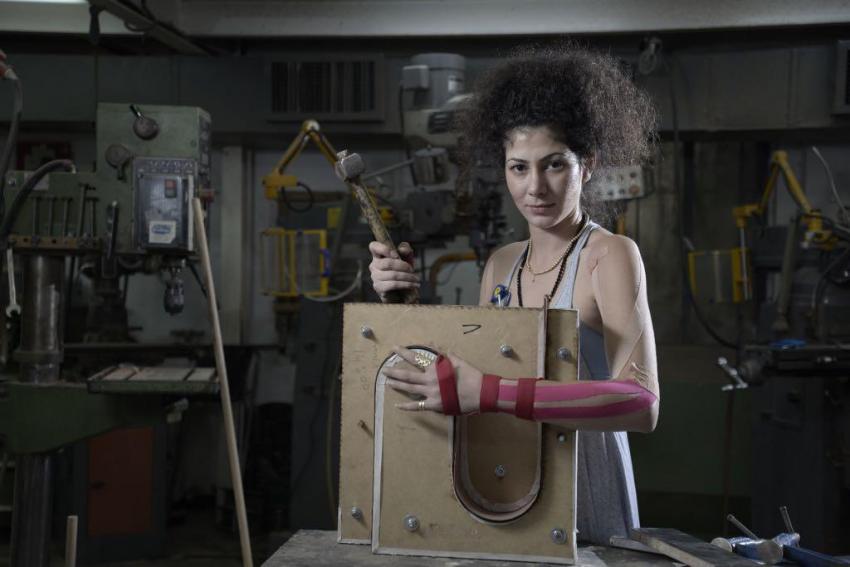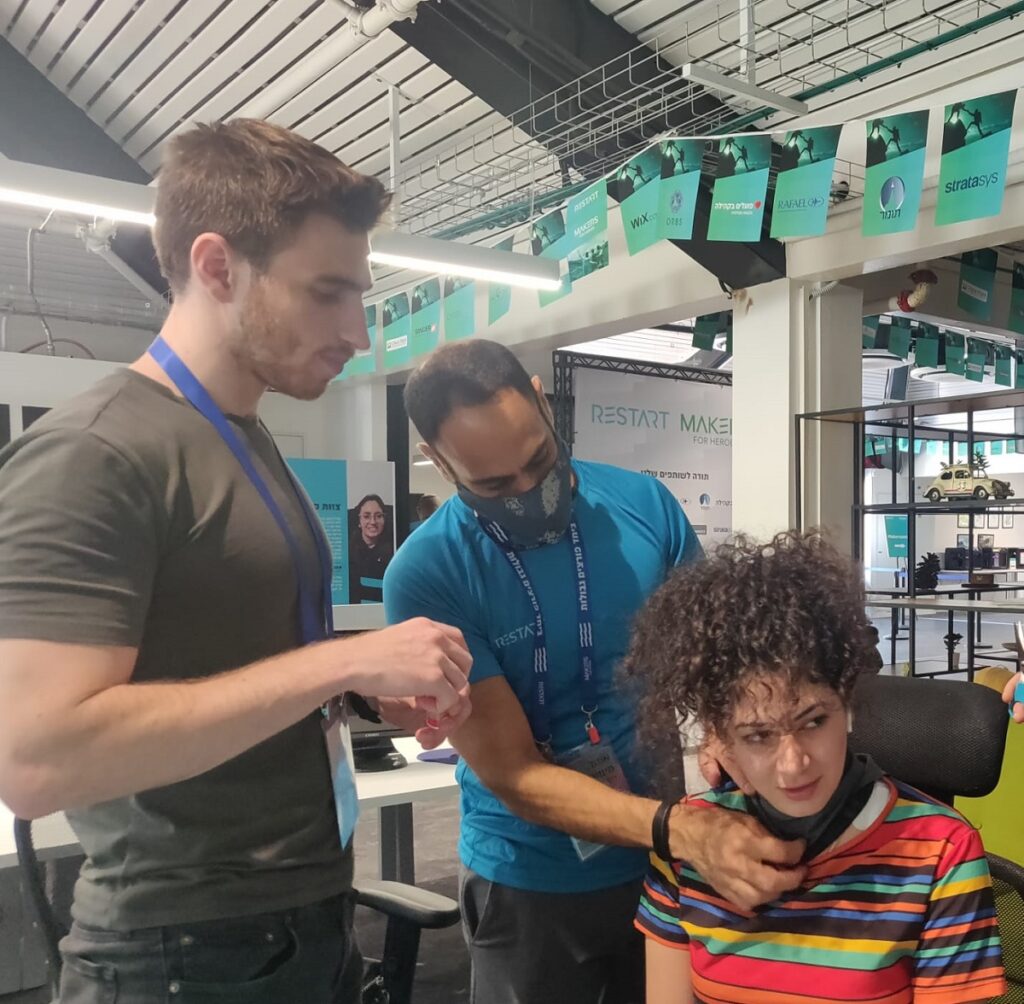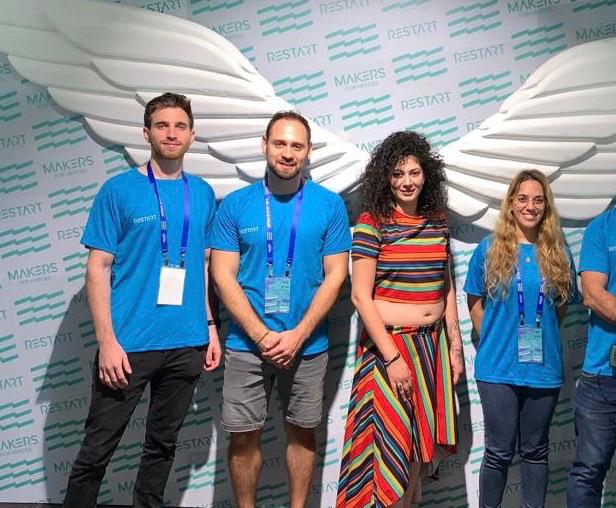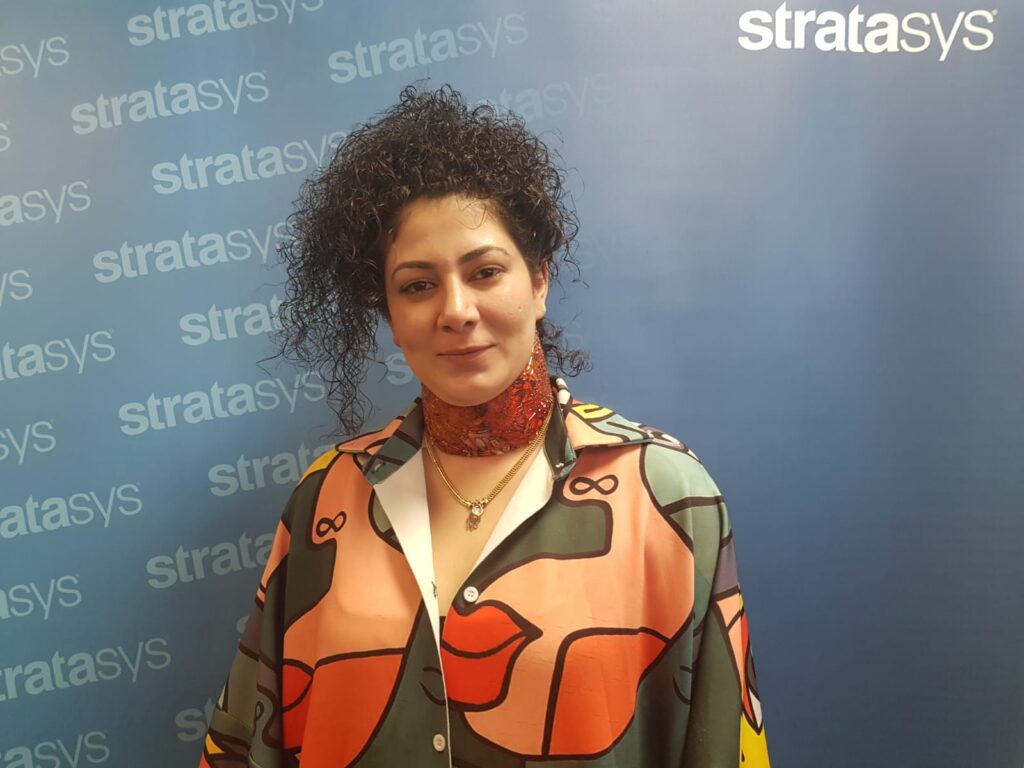Twelve years ago, Moran Barashi was a canine handler in the Israeli Air Force — training dogs to help during patrols — when she was in a car accident that flipped her jeep at the Palamachim base. Barashi woke up in the hospital, with no memory of the accident, but the repercussions were severe. She had a neurological injury in her neck that caused tics and pain ran continuously throughout her body.
The tics were frequent and disruptive to everyday life and Barashi began receiving botox injunctions to paralyze her muscles so the visibility of the tics would be weakened. While the injections helped, they also created other problems. Even years later, the injury continued to pose a challenge for the Hadassah College industrial design student and veterinarian.
“I had a very hard time holding my head up,” Barashi tells NoCamels. “I have a lot of muscles that are paralyzed from all the shots. It makes my daily life difficult and affects my whole body.”

While she is supposed to wear a brace around her neck all day long, existing solutions make her itchy, sweaty, uncomfortable, and cut off her air. The plastic smells after prolonged wear, she says. The neck brace has also been too ugly, hard, and plain for the self-proclaimed fashionista. “I wanted everyone to look at me because of my clothing, not my neck,” she explains.
“The sponge brace that is currently on the market is very hot and bulky and no one would have been happy to wear it,” she says.
Enter leading Israeli-based 3D printing manufacturer Stratasys where a team of volunteers decided to help Barashi find a better solution. Since 1998, Stratasys has been leading a global shift to additive manufacturing with solutions for the aerospace, automotive, consumer products, art, fashion, design, and healthcare industries.
The Stratasys team found Barashi through Restart’s Makers for Heroes, an Israeli project where “makers” (engineers, programmers, designers, doctors, tech experts, etc.) join forces to create innovative tech solutions that help injured soldiers overcome disabilities. The program was established in 2016 when Restart pioneers saw the concessions made by injured soldiers and aimed to “fulfill their dreams” by creating products that helped them overcome disabilities, and daily challenges, and establish a higher quality of living. In 2018 and 2019, the company collaborated with TOM: Tikkun Olam Makers, a global network of communities dedicated to improving lives by making open source technology affordable to all. Partners and sponsors in the Restart project include companies like Wix, Checkpoint Software Technologies, and Cyberpro Israel.
Stratasys has been part of the project for the last four years and has mainly worked with Paralympic athletes, including a member of Israel’s Paralympic rowing team and a tennis player, says Ohad Meyuhas, head of Innovation and CSR operation and the company’s team leader for the project.

This was the first time Meyuhas and the team focused on a 3D solution for someone with a specific disability rather than an athlete. “I wanted to do something like this for a long time,” Meyuhas explains. “Back then, I said that the challenge will be to design for the extreme — for the non-extreme.”
In other words, “Designing for a person with a disability should be so unique that it would not only help a person with a disability – but that a person without a disability would also want the final product. That’s the ideal for me,” Meyuhas reiterates, “And that’s what this was.“

Restart brought on 12 challengers for the 2021 project and Staratsys ultimately chose Barashi from four people they felt could be helped using 3D printing tech. The team scanned her with a 3D scanner and concluded that using hard materials on her collar would be problematic due to the regular botox shots she would get to the injured area.
“Due to her injury, she got tics and so her head was always moving. She needed to be with a neck brace all day long,” Meyuhas explains, “We wanted to produce a collar that would also support her head, and also be something that she would agree to put on that would look special. It also had to be something she would wear for several hours without feeling like her disability was accentuated.”
“We worked with her to understand what material would be best on her skin and wouldn’t create a rash,” he adds.
Sign up for our free weekly newsletter
SubscribeThe Stratasys team decided to create a simple, breathable, lightweight 3D printed scarf. The challenge, as Meyuhas explains, was to create something in place of a neck brace that would be appealing enough to be worn casually in everyday life. The team used fabric from a high fashion couture company they had worked with in the past — “think Chanel or Dior,” Meyuhas says — though he declined to name the label.
“If you met Moran, you would see that she is a fashionista. She’s unique. Whenever she came to our space, one could not ignore her. She was going to be in the center. And who would want to do that with a neck brace?” says Meyuhas.
“The look of the collar was important to me both because I also do design in general – but also because I match everything to what I wear – like hand splints but also fashion accessories like shoes – to my clothes,” Barashi adds, “If I’m already disabled, let it be in style.
Fashion in a 3D printed solution
Stratasys used a 3D printing PolyJet technology for the collar, which served as a support system on a fashionable fabric allowing freedom of movement and adaption to changes.
“We printed our design on beautiful fabrics that Moran really liked. We used the fabrics’ elasticity and textures and printed touch-proof materials unique to Stratasys in geometric shapes over it. We made sure that the collar could stabilize the neck and also look fashionable. The transparent material we used to print gives extra depth to the fabric that major fashion houses all over the world go crazy for and want to use,” Meyuhas explains.
Printing on different fabrics and textures gave Barashi multiple options, with different collars for all kinds of events. The varying geometry allowed some of the collars to ‘breathe’ more – a critical feature during the summer – while others were better suited for winter, or periods of, particularly strong neck pain.

According to Meyuhas, the new product is relatively light so she will not have to wear a heavy, stiff contraption around her neck. Barashi says Stratasys created hard, medium, and soft options in different designs which looked good and worked for her physical need, something that was “very important to me personally,” he says.
Barashi was very involved in the process and came into the company’s Rehovot office often. “Whenever there was a new concept or the formation of a new design, I came to the company physically to see how to move forward, take measurements, etc,” she tells NoCamels.
“Everything was under close supervision and compliance with industry standards to make sure the solution was safe to the touch and safe for Moran,” he says, “We also worked with physiotherapists and an accompanying team who guided us and helped us. With all the complicated solutions we tested, in the end, we came up with a relatively simple solution, that still functions as an ‘inclusive design’ – the fact that Moran tried on the collar and other people in the room said ‘Wow, that could be amazing for an event, it’s like a unique necklace, I would like to have one too.’ That means we succeeded”
“I have not met people with an injury like mine. I still hope it will help other people, and that was part of the goal, other than making it more beautiful and accessible to me – to also be more accessible and beautiful to the world and not just sick or disabled, which are the connotations that arise from what is currently on the market,” Barashi says.
“You look at an optimistic person like Moran. She talks about [her disability] and that’s fine, but at the same time, you want to help her in a way. The entire team got into that,” Meyuhas says, “We printed on top of the nice fabric with glossy transparent material, which gave it a feeling of super expensive and nice jewelry. She deserves that.
Related posts

Editors’ & Readers’ Choice: 10 Favorite NoCamels Articles

Forward Facing: What Does The Future Hold For Israeli High-Tech?

Impact Innovation: Israeli Startups That Could Shape Our Future




Facebook comments